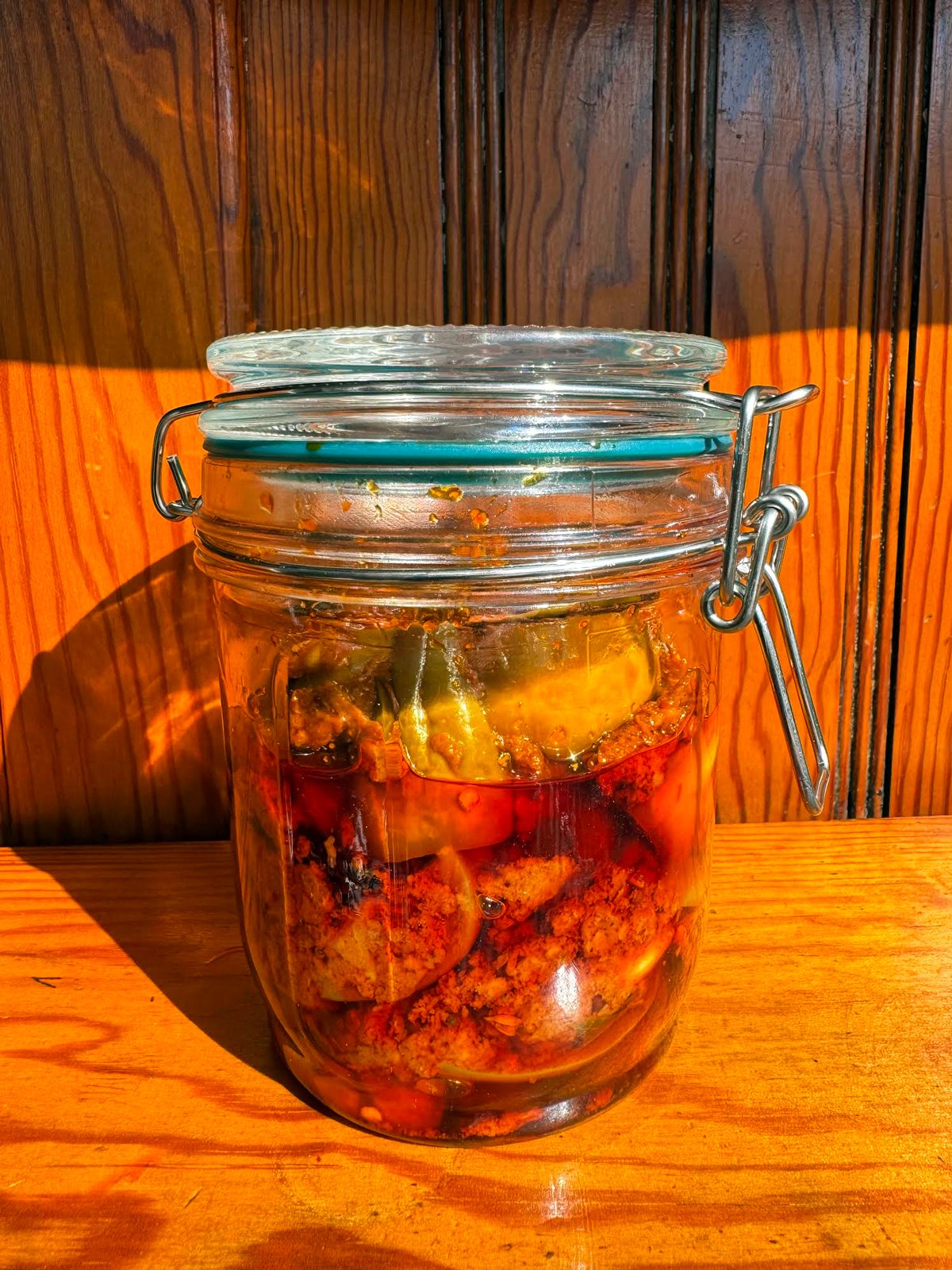 Spicy Eggplant Pickle, known as Vankaya Pachadi in Telugu, is a beloved staple in many homes across Andhra Pradesh and Telangana in South India. Traditionally, families prepare large batches of pickles to store for months, since preserving vegetables in oil and salt has been part of the regional food culture for centuries. In Andhra cuisine especially, pickles—called ooragaya - aren’t just condiments; they’re an essential part of daily meals.
Spicy Eggplant Pickle, known as Vankaya Pachadi in Telugu, is a beloved staple in many homes across Andhra Pradesh and Telangana in South India. Traditionally, families prepare large batches of pickles to store for months, since preserving vegetables in oil and salt has been part of the regional food culture for centuries. In Andhra cuisine especially, pickles—called ooragaya - aren’t just condiments; they’re an essential part of daily meals.
This recipe was originally made with small, tender purple brinjals that grow abundantly in local farms, but you can use regular globe eggplants without losing the rich taste. The pieces are cooked down with tangy tamarind, red chili powder, and freshly roasted spices, then submerged in sesame oil to develop a deep, complex flavor as they sit.
Beyond taste, many people believe pickles aid digestion because the spices and oil stimulate appetite and help balance heavier foods like rice and dal. They also reflect a practical approach to cooking - using preservation techniques passed down through generations to make sure seasonal produce can be enjoyed all year long. In many Andhra households, no meal feels complete without a little spoonful of something spicy and sour on the side, and this eggplant pickle is one of the most traditional ways to bring that vibrant kick to the plate.
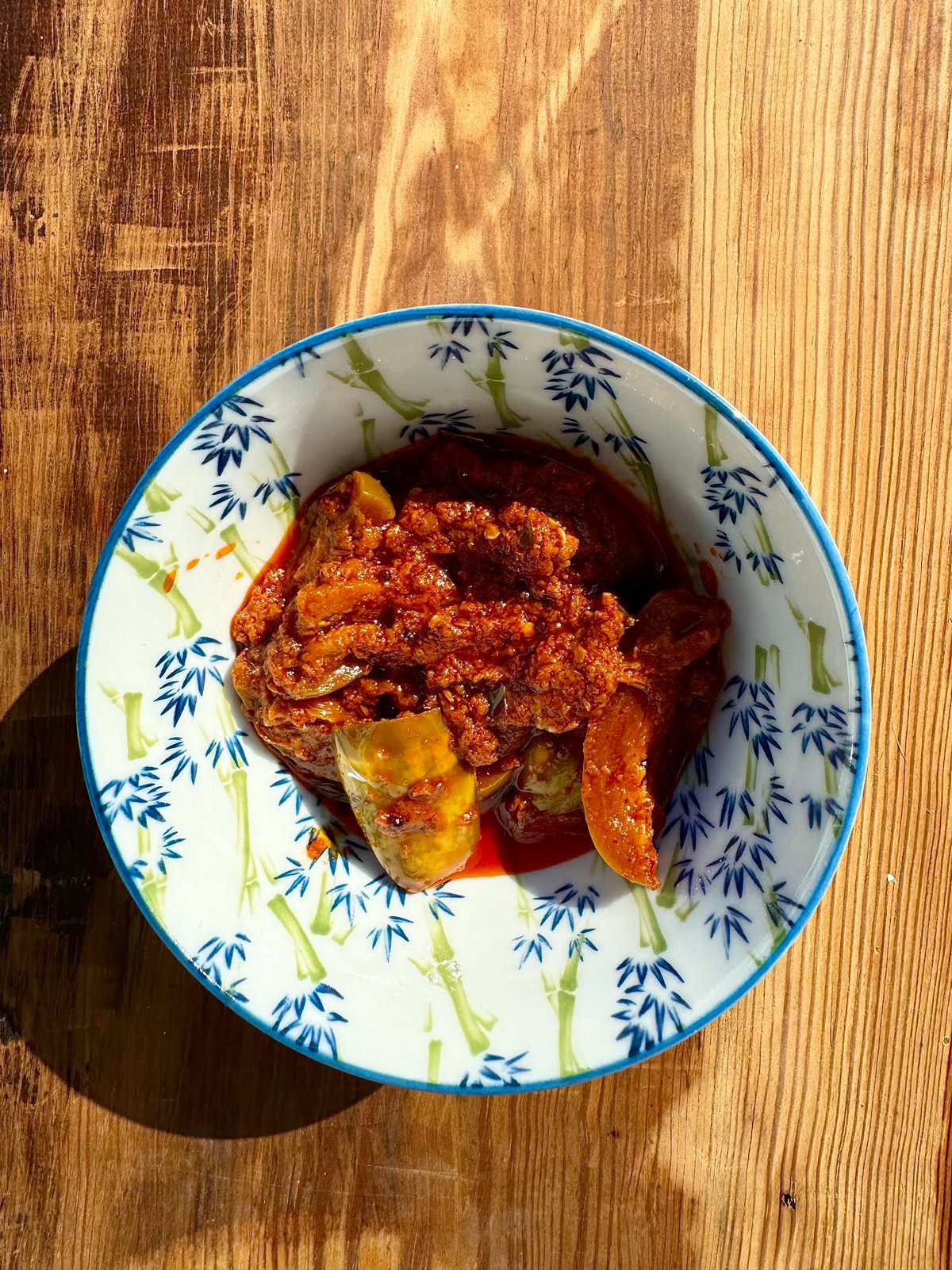
Spicy Eggplant Pickle (Vankaya Pachadi)
Ingredients
- 500 g eggplant
- ½ cup tamarind pulp soak tamarind in warm water and extract
- 1-3 tbsp red chili powder adjust to taste
- 1 teaspoon fenugreek seeds
- 1 teaspoon mustard seeds
- ½ teaspoon asafoetida powder
- 1 teaspoon turmeric powder
- 3 tablespoon sea salt or to taste
- 1 cup sesame gingelly oil (or groundnut oil)
- 1 tablespoon jaggery / Coconut sugar for mild sweetness
Instructions
- Prepare the eggplant: Wash and dry the eggplant.
- Cut into small cubes (about ½ inch).
- Spread on a clean cloth and leave to air-dry for 1–2 hours so excess moisture evaporates.
- Roast the spices: In a dry pan, roast fenugreek seeds on low heat until they smell nutty. Remove and cool.
- Roast mustard seeds until they start popping. Cool.
- Coarsely grind both into a powder.
- Cook the eggplant: Heat half the oil in a deep pan.
- Add asafoetida and broken red chilies if using.
- Add eggplant cubes and turmeric.
- Cook over medium heat until the pieces are soft and lightly browned, stirring occasionally (about 10–12 minutes).
- Mix the pickle: Let the eggplant cool completely.
- In a large bowl, combine chili powder, ground fenugreek-mustard, and salt.
- Stir in tamarind pulp.
- Add the cooked eggplant and mix well.
- Pour in the rest of the oil and stir to coat everything. Oil should cover the pickle to help preserve it.
- Taste and adjust salt or chili.
- If you like a hint of sweetness, mix in jaggery.
- Store: Transfer to a clean, dry glass jar.
- Leave at room temperature for 2–3 days so the flavors meld.
- Refrigerate afterward. Always use a clean, dry spoon.
Notes
- Drying the eggplant before cooking helps keep the pickle from getting soggy.
- Sesame (gingelly) oil gives the most authentic flavor, but groundnut oil works well too.
- Use gloves if handling lots of chili powder—it can irritate your skin.
- The longer it sits, the more the flavors develop.
- Always use a clean, dry spoon to avoid spoilage.
Recipe Twist Ideas:
-
- Extra Heat: Add crushed dried red chilies or a bit of green chili paste.
- Garlic Kick: Stir in a few cloves of roasted or raw garlic for more depth.
- Smoky Flavor: Char the eggplant cubes lightly before mixing for a subtle smokiness.
- Nutty Crunch: Mix in roasted peanuts or cashews before storing.
- Sour Note: Add a splash of lemon juice just before serving for extra tang.
Nutrition
FAQs
What type of eggplant works best for this pickle?
Traditionally, small purple Indian brinjals are used because they cook evenly and hold their shape. Regular globe eggplant works too; just cut it into small, even pieces and make sure to dry them well before cooking.
Why do I need to air-dry the eggplant first?
Removing surface moisture helps the eggplant fry instead of steaming. This keeps the pickle from becoming mushy and helps it store longer without spoiling.
How long can this pickle be stored?
If prepared with clean utensils and enough oil to cover the mixture, it keeps well in the refrigerator for several weeks. In traditional homes, versions stored in airtight jars with ample oil can last months.
Can I reduce the oil?
Oil acts as a natural preservative in this recipe. You can reduce it slightly if you plan to eat the pickle within a few days, but for longer storage it’s better not to cut back too much.
How spicy is this pickle?
Andhra pickles are known for their heat. You can adjust the chili powder to taste. Using Kashmiri chili powder gives color with moderate heat, while traditional Andhra chili powders are hotter.
Do I have to use sesame oil?
Sesame (gingelly) oil gives the most authentic flavor and helps preserve the pickle. Groundnut (peanut) oil is the best alternative if sesame isn’t available.
Why rest the pickle before eating?
Letting it sit for two to three days allows the tamarind, spices and oil to absorb into the eggplant, making the flavor deeper and more balanced.
How do I prevent spoilage?
Always use dry utensils, store in a clean glass jar and keep the pickle covered in oil. Avoid moisture, as water introduces bacteria and shortens shelf life.
- Region: Andhra Pradesh and Telangana, India
- Main flavors: Spicy, tangy, slightly nutty from sesame oil
- Key ingredients: Eggplant, tamarind, chili powder, mustard, fenugreek, sesame oil
- Prep method: Dry roast spices, fry eggplant, mix with tamarind and oil
- Storage: Glass jar, chilled after 2 to 3 days of resting
- Best with: Rice, roti, dosa, curd rice
- Shelf life: Several weeks in the fridge if kept dry and covered in oil
Troubleshooting
Watery pickle
This happens if the eggplant was not dried well or if the tamarind pulp had extra water. Next time, pat the eggplant dry and simmer the tamarind until thick.
Eggplant turned mushy
Too much moisture or high heat while cooking can soften it too much. Cook on medium heat and stir gently so the cubes hold shape.
Pickle tastes bitter
Fenugreek can turn bitter if over roasted. Roast just until fragrant and light golden, not dark.
Pickle smells sour too fast
Moisture likely entered the jar. Always use a dry spoon and make sure the pickle is fully covered in oil.
Not spicy or flavorful enough
Andhra pickles build flavor as they sit. Give it a day or two. If still mild, mix a little extra chili powder and salt in warm oil and stir in.
Oil rising to the top
This is normal for traditional pickles. Stir before serving. The oil also helps preserve, so do not discard it.
Try it with my jowar roti or bhatura — both pair perfectly with the spicy, tangy flavors.



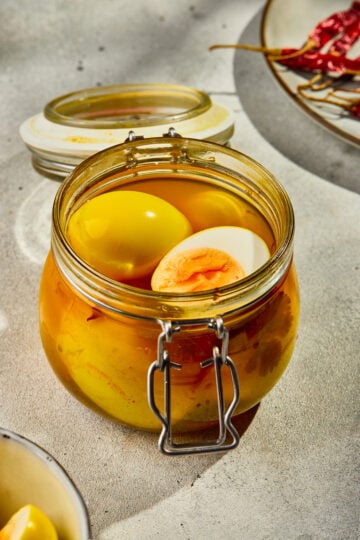
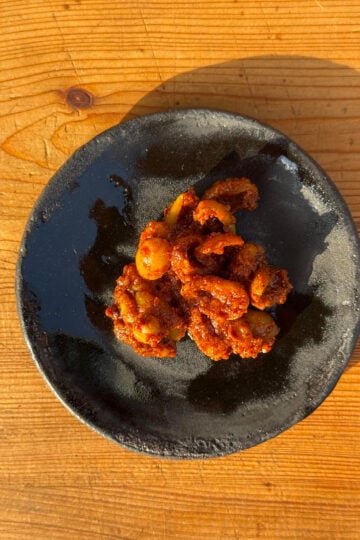
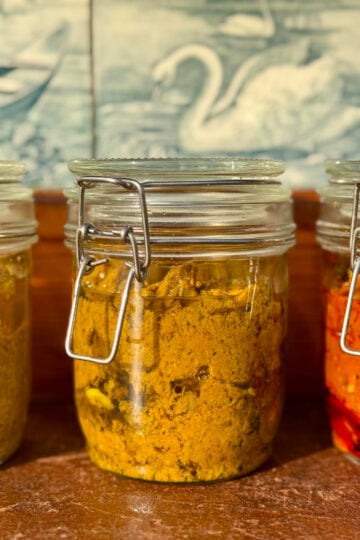
Have a question or something to share? Leave a comment below!